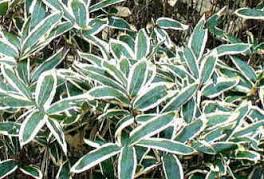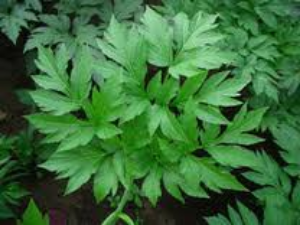Last edited, 13 April 2020.
Kumazasa and Ashitaba are two wonders of plant food native to Japan. Understanding how the names come about is going to make you impress with the plants.
Kumazasa
This is Kumazasa. “Kuma” in Japan means bear and “zasa” means bamboo.

The most interesting story is that the leaves are a bear’s first meal after hibernation. The bears consume large amount of food before hibernation. During the period of hibernation which is around 6-8 months, waste from digestion circulates in their bodies through their blood. By consuming kumazasa after hibernation, bears can purify and deoxify their blood.
In Japan, horses and cows that eat wild kumazasa have been observed to be healthier as well!
In fact, we do see Kumazasa in Singapore as well. When you visit Japanese restaurants, some lined kumazasa below the sashimi served. Touch the leaf next time, it has a volatile oil on the surface.
In Japan, they use it to wrap food such as raw fish to prevent spoilage and impart its fragrance to the content. The leaves have anti-bacterial properties.

Kumazasa has been valued for many of its properties such as as a disinfectant, antiseptic, expectorant and even a remedy for bad breath. The following long list of benefits have also been documented:
For the cardiovascular system
Cholesterol can be trapped in the walls of our blood vessels and making them losing their elasticity. This in turn affects the expandability which can cause poor blood circulation and high blood pressure.
Kumazasa has a cleaning effect on the blood. Its polysaccharides can reduce excess cholesterol in blood vessels to help them regain vitality and elasticity. The nutrients can enhance regeneration and strengthening of blood vessels to prevent atherosclerosis.
For Digestive system
Kumazasa can enhance liver functions, enable it to work more efficiently as the body’s filter. Its lignin also has cleansing effects on the liver. Kumazasa polysaccharides have cholesterol-lowering effects which can prevent gallstones from forming in the gallbladder as well.
Cells
Bamfolin, a type of polysaccharide in Kumazasa has anti-cancer properties. It also has ability to strengthen cell membranes so that the cells’ absorption of nutrients and detoxification are smoother.
Acid-base balance
Normal body functions depend on the acid-base balance in the body. If the body is acidic, acidosis occurs. This may be caused by illness or an imbalanced diet. Kumazasa can help to counter acidosis with its vitamin K content.
Wound Healing
Kumazasa’s chlorophyll has antiseptic effect on areas surrounding wounds and triggers cell activity to activate tissue growth. Chlorophyll is said to be particularly effective on burns, scars from burns and skin disorders.
Anti-bacterial
The anti-bacterial property of chlorophyll in Kumazasa can help to eliminate bacteria that cause bad breath and relieve stomatitis (an inflamed and sore mouth commonly caused by ulcers or sores).
Anti-vial
Researchers found that Kumazasa extract was effective against influenza A (flu) virus infection. The extract interfered with viral replication and stimulated production of virus-specific antibodies.
Nutrients
Chlorophyll and protein (in the form of amino acids) make up of 80 and 13 percent of Kumazasa respectively, giving it twice as much as protein as milk. It has several times the amount of amino acids in rice or milk. Essential amino acids in Kumazasa include tryptophan, lysine, threonine, methionine, phenylalanine, leucine, isoleucine and valine.
Kumazasa is also rich in vitamin K, phosphorous, vitamin B and vitamin C.
Ashitaba
The next impressive one is Ashitaba. It is native to Japan’s Hachijo Island. It is well-known as a longevity herb.

“Ashita” means tomorrow in Japanese. “Ba” means leaf. In short, it is tomorrow leaf. Pluck a leaf today and a new one will sprout tomorrow. Yes, literally.
This is a plant with such a strong life force.
Hachijo island is used to be a place of exile for convicts during the Edo period. Despite hard labor and poor diets, the convicts live a long lives. Their unlikely longevity was attributed to ashitaba that they foraged for.
The following is the list of ashitaba benefits:
Nutrients
Flavonoids
These are naturally occurring plant pigments with antioxidant effects. Flavonoids have been linked to a reduced risk of cancer, heart disease, asthma, and stroke.
Coumarins
Potent antioxidants with anti-cancer properties. Abundant in ashitaba. An example of a coumarin in ashitaba is laserpitin.
Chlorophyll
Ashitaba is rich in chlorophyll, the green pigment in plants that collect and store energy from the sun. Chlorophyll stimulates the production of red blood cells. It is also excellent for cleansing the blood and liver and promotes “friendly” intestinal bacteria. It has antioxidant properties and helps prevent DNA damage, thereby inhibiting cancer activation.
Chalcones
When you cut the stem of ashitaba, you will see a sticky yellow sap flows out. This sap contains mainly chalcones, a very precious nutrients with only a few milligrams that can be collected from the stem. The two main types of chalcones in ashitaba are xanthoangelol and 4-hydroxyderricin. They are also polyphenols. Polyphenols act as powerful antioxidants and help fight free radical damage.
They also inhibit tumor growth and spread, prolong lives in animal models with lung cancer.
4-hydroxyderricin is seen to prevent the drop of cancer-fighting cells such as lymphocytes, natural killer cells etc, in the spleen of tumor-removed mice. It also exhibits potent cytotoxic activities against leukemia, melanoma, and cancers of the lung and stomach.
Anti-allergic effect
Xanthoangelol B, xanthoangelol C and xanthoangelol E in ashitaba inhibit histamine release, thereby preventing any allergic reaction.
Blood Glucose
Ashitaba is abundant in 4-hydroxyderricin and xanthoangelol that is a promising functional food for regulating blood glucose levels. 4-hydroxyderricin and xanthoangelol show strong insulin-like activities.
Bone health
Ashitaba helps promote bone formation and increase bone mass. A promising ingredient for treatment of osteoporosis and prevention of osteopenia.
Gastrointestinal Health
Ashitaba speeds up waste elimination and improves digestion. It is seen superb for those with weak digeston, or gastric or duodenal ulcers. It is a natural diuretic removing toxins from the body.
Nervous System
Chalcones have been found to stimulate production of Nerve Growth Factor (NGF), which is essential in the development and survival of certain nerve cells in the peripheral and central nervous system. NGF have the potential to alleviate Alzheimer’s disease and peripheral neuropathy.
Weight Management
Visceral fat (also known as abdominal fat) has been linked to metabolic disturbances and increased risk of cardiovascular disease, type 2 diabetes and breast cancer. Evidence from a human clinical study and animal studies indicates that ashitaba chalcones may help reduce visceral fat. Xanthoangelol and 4-hydroxyderricin help to enhance fat metabolism and inhibit fat accumulation respectively.
![]()
